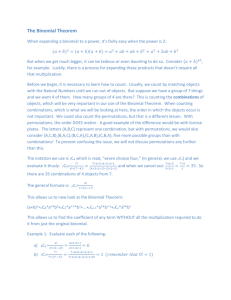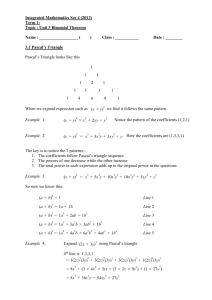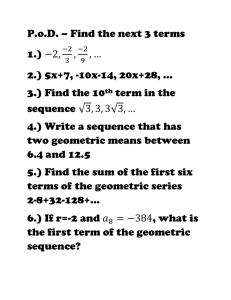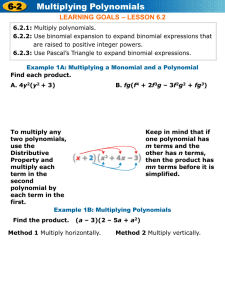Pascal's triangle, triangular recurrence, Bernoulli
advertisement
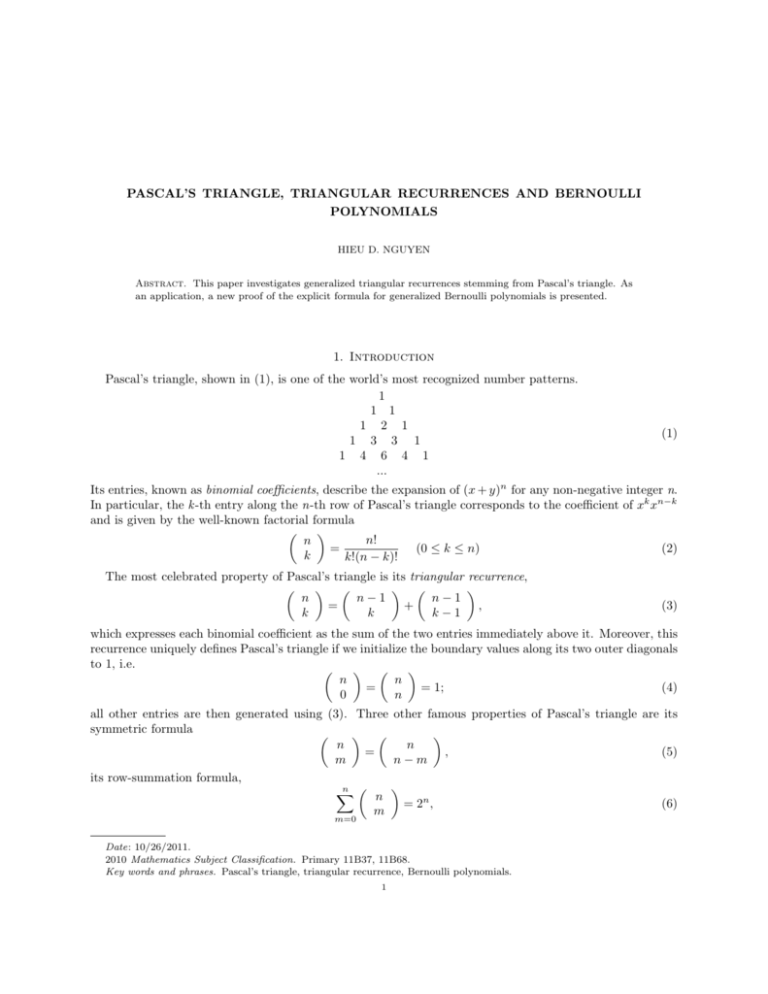
PASCAL’S TRIANGLE, TRIANGULAR RECURRENCES AND BERNOULLI
POLYNOMIALS
HIEU D. NGUYEN
Abstract. This paper investigates generalized triangular recurrences stemming from Pascal’s triangle. As
an application, a new proof of the explicit formula for generalized Bernoulli polynomials is presented.
1. Introduction
Pascal’s triangle, shown in (1), is one of the world’s most recognized number patterns.
1
1 1
1 2 1
1 3 3 1
1 4 6 4 1
...
(1)
Its entries, known as binomial coefficients, describe the expansion of (x + y)n for any non-negative integer n.
In particular, the k -th entry along the n-th row of Pascal’s triangle corresponds to the coefficient of xk xn−k
and is given by the well-known factorial formula
n!
n
=
(0 ≤ k ≤ n)
(2)
k
k!(n − k)!
The most celebrated property of Pascal’s triangle is its triangular recurrence,
n
n−1
n−1
=
+
,
k
k
k−1
(3)
which expresses each binomial coefficient as the sum of the two entries immediately above it. Moreover, this
recurrence uniquely defines Pascal’s triangle if we initialize the boundary values along its two outer diagonals
to 1, i.e.
n
n
=
= 1;
(4)
0
n
all other entries are then generated using (3). Three other famous properties of Pascal’s triangle are its
symmetric formula
n
n
=
,
(5)
m
n−m
its row-summation formula,
n X
n
= 2n ,
(6)
m
m=0
Date: 10/26/2011.
2010 Mathematics Subject Classification. Primary 11B37, 11B68.
Key words and phrases. Pascal’s triangle, triangular recurrence, Bernoulli polynomials.
1
2
HIEU D. NGUYEN
and its connection to the Fibonacci numbers Fn where F0 = 0, F1 = 1 and Fn+1 = Fn + Fn−1 :
bn/2c X
m=0
n−m
m
= Fn+1 .
(7)
A historical treatment of Pascal’s triangle and its classical properties can be found in [2].
Another useful, but less popular form, of Pascal’s triangle is that of an infinite rectangular array (also
referred to as Pascal’s matrix or square), where infinitely many 0’s are appended to both ends of each row
as shown in (8):
(k = −1) (k = 0) (k = 1) (k = 2) (k = 3) ...
(n = 0) ...
0
1
0
0
0
0 ...
(n = 1) ...
0
1
1
0
0
0 ...
(8)
(n = 2) ...
0
1
2
1
0
0 ...
(n = 3) ...
0
1
3
3
1
0 ...
...
In this case, it suffices to initialize only those values along the first row (n = 0) as follows:
0
≡ δ0,k , k ∈ Z
k
(9)
where
δi,j =
1
0
if i = j
if i =
6 j
(10)
is Kronecker’s delta. Again, all other binomial coefficients can be generated from the triangular recurrence.
Our motivation for considering this second approach to initializing Pascal’s triangle is that it yields
interesting generalizations of triangular recurrences, binomial coefficients, and Fibonacci numbers. Towards
this end, let x(n, k) be any two-dimensional sequence which satisfies the triangular recurrence, i.e.
x(n, k) = x(n − 1, k) + x(n − 1, k − 1),
(11)
but whose values along row n = 0 are prescribed by a bi-directional sequence f (k), i.e.
x(0, k) = f (k), k ∈ Z
(12)
Let’s now generate the values of x(n, k) along other rows using (11). An explicit calculation of rows n = 1
and n = 2 in terms of f (k) yields
x(1, k)
x(2, k)
= x(0, k) + x(0, k − 1) = f (k) + f (k − 1)
= x(1, k) + x(1, k − 1) = [f (k) + f (k − 1)] + [f (k − 1) + f (k − 2)]
= f (k) + 2f (k − 1) + f (k − 2)
(13)
The reader can verify that the next two rows are given by
x(3, k) = f (k) + 3f (k − 1) + 3f (k − 2) + f (k − 3)
x(4, k) = f (k) + 4f (k − 1) + 6f (k − 2) + 4f (k − 3) + f (k − 4)
(14)
It is clear that the coefficients appearing in the expansions above are precisely the binomial coefficients
and that the following convolution formula holds:
n X
n
x(n, k) =
f (k − m)
(15)
m
m=0
This demonstrates that binomial coefficients can be considered as fundamental building blocks for generating
all two-dimensional sequences which satisfy the triangular recurrence. In fact, we can take (15) as the
PASCAL’S TRIANGLE, TRIANGULAR RECURRENCES AND BERNOULLI POLYNOMIALS
definition for binomial coefficients and recover Pascal’s triangle by setting f (k) = δ0,k :
n X
n
n
x(n, k) =
δ0,k =
m
k
3
(16)
m=0
Observe also that if f (k) = 1, then (15) reduces to the summation formula (6) and the values of x(n, k) form
the elementary number array
(k = −1) (k = 0) (k = 1) (k = 2) (k = 3) (k = 4)
(n = 0) ...
1
1
1
1
1
1
...
(n = 1) ...
2
2
2
2
2
2
...
(17)
(n = 2) ...
4
4
4
4
4
4
...
(n = 3) ...
8
8
8
8
8
8
...
...
In this paper we describe the fundamental building blocks for two-dimensional sequences x(n, k) satisfying
the generalized triangular recurrence
x(n, k) = a(n, k)x(n − 1, k) + b(n, k)x(n − 1, k − 1),
(18)
where a(n, k) and b(n, k) are arbitrarily given two-dimensional sequences. Along the way we discuss various
generalizations of binomial coefficients and the notion of rank for comparing the relative size of an integer
with respect to a given subset. As a result, we obtain a new explicit formula for x(n, k) (Theorem 1). As
an application, we give a different proof of Dilcher’s formula ([1], Theorem 2), which expresses generalized
Bernoulli polynomials in terms of classical Bernoulli polynomials. We conclude by presenting a generalization
of our results to three-term recurrences (Theorem 3).
2. Triangular Recurrences
We begin our study of generalized triangular recurrences by first considering the simple case where
x(n, k) = ax(n − 1, k) + bx(n − 1, k − 1)
and a and b are constants. It is straightforward to show that
n X
n
x(n, k) =
an−m bm f (k − m)
m
(19)
(20)
m=0
which resembles a weighted binomial expansion of (a + b)n . Indeed, the coefficients in (20) can be generated
by expanding the binomial (ax + by)n . This leads to the following extension of binomial coefficients where
we define
n
n
≡
an−m bm
(21)
m
m
a
b
Observe that the following symmetric formula holds:
n
n
=
m b b n−m a
a
which is analogous to (5). Moreover, the summation formula (6) generalizes to
X
n n X
n
n
≡
an−m bm = (a + b)n
m
m
a
b
m=0
(22)
(23)
m=0
It is also straightforward to demonstrate using an induction argument that the generalized Fibonacci numbers
Fn (a, b) defined by
4
HIEU D. NGUYEN
Table 1. Indices of x(3, k)
Terms of x(3, k)
a(1)a(2)a(3)(k)
b(1)a(2)a(3)f (k −1)
a(1)b(2)a(3)f (k −1)
a(1)a(2)b(3)f (k −1)
b(1)b(2)a(3)f (k − 2)
b(1)a(2)b(3)f (k − 2)
a(1)b(2)b(3)f (k − 2)
b(1)b(2)b(3)f (k − 3)
Indices of factors
involving b
∅
{1}
{2}
{3}
{1, 2}
{1, 3}
{2, 3}
{1, 2, 3}
bn/2c Fn+1 (a, b) ≡
X
m=0
a
n−m
m
(24)
b
satisfy the linear recurrence
Fn+1 (a, b) = aFn (a, b) + bFn−1 (a, b)
(25)
For a = b = 1, (25) reduces to the recurrence for the classical Fibonacci numbers Fn .
Next, let’s assume that the more general recurrence holds:
x(n, k) = a(n)x(n − 1, k) + b(n)x(n − 1, k − 1)
(26)
where a(n) and b(n) are one-dimensional sequences. In this case, the situation becomes much more interesting. To gain some intuition, let’s write out x(n, k) explicitly for the first several values of n:
x(0, k) = f (k)
x(1, k) = a(1)f (k) + b(1)f (k − 1)
x(2, k) = a(1)a(2)f (k) + [b(1)a(2) + a(1)b(2)]f (k − 1) + b(1)b(2)f (k − 2)
x(3, k) = a(1)a(2)a(3)f (k)
(27)
+[a(1)a(2)b(3) + a(1)b(2)a(3) + b(1)a(2)a(3)]f (k − 1)
+[a(1)b(2)b(3) + b(1)a(2)b(3) + b(1)b(2)a(3)]f (k − 2)
+b(1)b(2)b(3)f (k − 3)
To establish a pattern for the coefficients of x(3, k) above, we tabulate the indices of the factors involving
b in each term (see Table 1). The pattern is now clear: the coefficients of f are prescribed by subsets of
{1, 2, 3}. More formally, let An = {1, 2, ..., n} and denote by An (m) the collection of m-element subsets of
An . Then given any subset σ = {i1 , i2 , ..., im } ∈ An (m), define
a(σ) ≡ a(i1 )a(i2 ) · · · a(im )
b(σ) ≡ b(i1 )b(i2 ) · · · b(im )
(28)
Thus,
x(n, k) =
n
X
X
m=0
a(σ̄)b(σ) f (k − m)
(29)
σ∈An (m)
where σ̄ denotes the set complement of σ. Again, the coefficients appearing in (29), namely
X
a(σ̄)b(σ),
σ∈An (m)
(30)
PASCAL’S TRIANGLE, TRIANGULAR RECURRENCES AND BERNOULLI POLYNOMIALS
define a further generalization of binomial coefficients, which we again denote by
a
the symmetric formula (22) continues to hold since
P
n
= σ∈An (m) a(σ̄)b(σ)
m
a
b
P
= τ ∈An (n−m) b(τ̄ )a(τ )
=
b
As for the summation formula, we have
n X
m=0 a
n
m
n
n−m
n
Y
=
b
n
m
5
. Observe that
b
(τ = σ̄)
(31)
a
[a(m) + b(m)]
(32)
m=1
which suggests that the generalized binomial coefficients in this case can be generated from the expansion of
n
Y
[a(m)x + b(m)y]
(33)
m=1
Continuing further in our investigation of generalized triangular recurrences, let’s assume that x(n, k)
satisfies the recurrence
x(n, k) = a(k)x(n − 1, k) + b(k)x(n − 1, k − 1)
(34)
where a(k) and b(k) are again one-dimensional sequences, but dependent on the second index k instead of
the first index n. How does this affect our formula for x(n, k)? Again, let’s write out x(n, k) explicitly for
the first several values of n:
x(0, k) = f (k)
x(1, k) = a(k)f (k) + b(k)f (k − 1)
x(2, k) = a(k)a(k)f (k) + [a(k − 1)b(k) + b(k)a(k)]f (k − 1) + b(k − 1)b(k)f (k − 2)
x(3, k) = a(k)a(k)a(k)f (k)
+[b(k)a(k)a(k) + a(k − 1)b(k)a(k) + a(k − 1)a(k − 1)b(k)]f (k − 1)
+[b(k − 1)b(k)a(k) + b(k − 1)a(k − 1)b(k) + a(k − 2)b(k − 1)b(k)]f (k − 2)
+b(k − 2)b(k − 1)b(k)f (k − 3)
(35)
The pattern in this case appears more complicated than the previous case due to shifts in certain indices.
To shed some light into the matter, we first fix an ordering for how the factors a and b appear in each
coefficient: indices should be written left to right in ascending order and if two factors have the same index,
then they are written left to right in reverse-alphabetical order. For example, the expansions in (35) are
written using this ordering. Next, we compare the shifts of each index with the corresponding positions of
the factors involving b. In particular, we denote by ij to indicate the shift in the index of the j -th factor of
a given coefficient. Table 2 itemizes each term of x(3, k) and describes the positions of the factors involving
b for each term and shifts of its indices.
We observe that the second column in the Table 2 itemizes all subsets of {1, 2, 3}. Is there a connection
between the second and third columns? Yes, it appears that the shift in the index of a given factor (third
column) depends on the number of factors involving b (second column) that are higher in position, i.e.
further to the right. We formalize this pattern by introducing a rank function to indicate the relative size of
an integer with respect to a given subset. Let σ = {i1 , i2 , ..., im } ∈ An (m). We define the rank of a positive
integer j relative to σ, and denote it by Iσ (j), to be the number of elements in σ that are greater than j, i.e.
Iσ (j) = |{i ∈ σ : i > j}|
6
HIEU D. NGUYEN
Table 2. Indices of x(3, k)
Terms of x(3, k)
a(k)a(k)a(k)f (k)
b(k)a(k)a(k)f (k − 1)
a(k − 1)b(k)a(k)f (k − 1)
a(k − 1)a(k − 1)b(k)f (k − 1)
b(k − 1)b(k)a(k)f (k − 2)
b(k − 1)a(k − 1)b(k)f (k − 2)
a(k − 2)b(k − 1)b(k)f (k − 2)
b(k − 2)b(k − 1)b(k)f (k − 3)
Positions of factors
involving b
∅
{1}
{2}
{3}
{1, 2}
{1, 3}
{2, 3}
{1, 2, 3}
Index Shifts of
Factors (i1 , i2 , i3 )
(0, 0, 0)
(0, 0, 0)
(1, 0, 0)
(1, 1, 0)
(1, 0, 0)
(1, 1, 0)
(2, 1, 0)
(2, 1, 0)
For example, if σ = {1, 2, 4} ∈ A5 (3), then Iσ (3) = 1 since there is only one element in σ, namely 4, that is
greater than 3. We also have Iσ (5) = 0. In general, Iσ (n) = 0 for every subset σ ∈ An (m). We also define
a(σ; k) = a(k − Iσ (i1 ))a(k − Iσ (i2 )) · · · a(k − Iσ (im ))
b(σ; k) = b(k − Iσ (i1 ))b(k − Iσ (i2 )) · · · b(k − Iσ (im ))
(36)
where in the case of the empty set we define
a(∅; k) = b(∅; k) =
1
0
if n = 0
if n =
6 0
As a result, we are now able to express x(n, k) by the formula
n
X
X
a(σ̄; k)b(σ; k) f (k − m)
x(n, k) =
m=0
In this case the coefficients
a
n
m
(37)
(38)
σ∈An (m)
[k] ≡
b
X
a(σ̄; k)b(σ; k)
(39)
σ∈An (m)
define a generalization of binomial coefficients that is rather different from (30). Again, by the same reasoning,
we find that the symmetric formula continues to holds, namely
n
n
[k]
(40)
[k] =
m b
m a
a
b
However, there appears to be no analogous summation formula, or at least the author is not aware of such
a formula.
This brings us to the last case where we assume that x(n, k) satisfies the most general recurrence given by
(18) in terms of arbitrary two-dimensional sequences a(n, k) and b(n, k). Given σ = {i1 , i2 , ..., im } ∈ An (m),
we define
Qm
a(σ; k) = Q r=1 a(ir , k − Iσ (ir ))
(41)
m
b(σ; k) = s=1 b(is , k − Iσ (is ))
and again, if σ = ∅ ∈ An (0), then we set a(∅; k) and b(∅; k) as in (37). By combining the results of the two
previous cases, we obtain the following main result.
Theorem 1: Suppose the two-dimensional sequence x(n, k) satisfies the generalized triangular recurrence
x(n, k) = a(n, k)x(n − 1, k) + b(n, k)x(n − 1, k − 1)
x(0, k) = f (k)
PASCAL’S TRIANGLE, TRIANGULAR RECURRENCES AND BERNOULLI POLYNOMIALS
where n is a non-negative integer and k ∈ Z. Then
n
X
X
x(n, k) =
m=0
7
a(σ̄; k)b(σ; k) f (k − m)
(42)
σ∈An (m)
Proof: For n = 0, formula (42) reduces to x(0, k) = f (k). By induction on n, we have
x(n + 1, k) = a(n + 1, k)x(n, k) +
b(n + 1, k)x(n, k − 1) Pn P
= a(n + 1, k) m=0
σ∈An (m) a(σ̄; k)b(σ; k) f (k − m)
Pn P
+b(n + 1, k) m=0
σ∈An (m) a(σ̄; k − 1)b(σ; k − 1) f (k − 1 − m)
Pn P
= m=0
a(n
+
1,
k)a(σ̄;
k)b(σ;
k)
f (k − m)
σ∈An (m)
Pn P
+ m=0
σ∈An (m) b(n + 1, k)a(σ̄; k − 1)b(σ; k − 1) f (k − 1 − m)
Next, assume σ = {i1 , i2 , ..., im } ∈ An (m) so that σ̄ = {j1 , j2 , ..., jn−m } ∈ An (n − m). Then
X
X
a(n + 1, k)a(σ̄; k)b(σ; k) =
σ∈An (m)
a(n + 1, k)
a(jr , k − Iσ (jr ))
r=1
n+1−m
Y
σ∈An (m)
X
=
n−m
Y
a(jr , k − Iσ (jr ))
σ ∈ An+1 (m)
n+1∈
/σ
m
Y
b(is , k − Iσ (is ))
s=1
m
Y
b(is , k − Iσ (is ))
s=1
r=1
Since Iσ0 (j) = Iσ (j) + 1 for σ ∈ An (m), σ 0 = σ ∪ {n + 1}, and 1 ≤ j < n + 1, we deduce that
X
b(n + 1, k)a(σ̄; k − 1)b(σ; k − 1) =
σ∈An (m)
X
b(n + 1, k)
σ∈An (m)
X
=
=
σ 0 ∈ An+1 (m + 1)
n + 1 ∈ σ0
X
n−m
Y
a(jr , k − 1 − Iσ (jr ))
r=1
n−m
Y
a(jr , k − Iσ0 (jr ))
m
Y
b(is , k − 1 − Iσ (is ))
s=1
m
Y
b(is , k − 1 − Iσ0 (is ))
s=1
r=1
a(σ̄ 0 ; k)b(σ 0 ; k)
σ 0 ∈ An+1 (m + 1)
n + 1 ∈ σ0
We partition An+1 (m) into those subsets that contain the integer n + 1 and those that do not. It follows
that
n
X
X
x(n + 1, k) =
m=0
σ ∈ An+1 (m)
n+1∈
/σ
+
Pn
m=0
n+1−m
Y
r=1
a(jr , k − Iσ (jr ))
b(is , k − Iσ (is )) f (k − m)
s=1
m
Y
P
σ 0 ∈ An+1 (m + 1) a(σ̄; k)b(σ; k) f (k − 1 − m)
n + 1 ∈ σ0
8
HIEU D. NGUYEN
Then employing the definitions for a(σ̄; k) and b(σ; k), we obtain
x(n + 1, k) =
Pn+1 P
Qn+1−m
Qm
a(jr , k − Iσ (jr )) s=1 b(is , k − Iσ (is )) f (k − m)
m=0
r=1
σ ∈ An+1 (m)
/σ
n+1∈
Pn+1 P
0
0
m=1
σ 0 ∈ An+1 (m) a(σ̄ ; k)b(σ ; k) f (k − m)
n + 1 ∈ σ0
Pn+1 P
= m=0
a(σ̄;
k)b(σ;
k)
f (k − m)
σ∈An+1 (m)
+
This completes the proof and yields our last generalization of binomial coefficients, which we again define
using (39). Again, it is straightforward to check that the symmetric formula holds.
3. Application to Bernoulli Polynomials
As an application of our Main Theorem, we prove Dilcher’s formula ([1]) for generalized Bernoulli polynomials in terms of classical Bernoulli polynomials Bn (z). The latter arises in many important applications
involving special functions such as the Riemann zeta function.
(p)
Let p be a positive integer. Then the generalized Bernoulli polynomials Bn (z) of order p are defined by
the generating function
∞
X
tp ezt
tn
=
Bn(p) (z)
(43)
t
p
(e − 1)
n!
n=0
If p = 1, then Bnp (z) reduces to the classical Bernoulli polynomials Bn (z). Since
!
Y
p p
∞
Y
X
tp ezt
tezq t
tn
=
=
Bn (zq )
(et − 1)p
et − 1
n!
q=1
q=1 n=0
(44)
where z = z1 + ... + zp , it follows from equating (43) and (44) that
X
n!
Bi (z1 ) · · · Bip (zp ) = Bn(p) (z)
Sn,p (z) ≡
i1 ! · · · ip ! 1
i1 ≥ 0, i2 ≥ 0, ..., .ip ≥ 0
i1 + i2 + ... + ip = n
(45)
In [3], Nörlund proved that the generalized Bernoulli polynomials satisfy the generalized triangular recurrence
n
z
(p−1)
Bn(p) (z) = 1 −
Bn(p−1) (z) + n
− 1 Bn−1 (z)
(46)
p−1
p−1
for n > p ≥ 1. By applying our Main Theorem to this recurrence, we obtain the following corollary.
Corollary: The generalized Bernoulli polynomials are given in terms of the classical Bernoulli polynomials
by
p−1
X
X
Bn(p) (z) =
a(σ̄; n)b(σ; n) Bn−k (z)
(47)
k=0
σ∈Ap−1 (k)
(p+1)
Proof: Formula (47) follows immediately from (42) by setting x(p, n) = Bn
b(p, n) = n pz − 1 .
(z), a(p, n) = 1 −
n
p
and
The following properties of the rank function will be useful in demonstrating that formula (47) reduces
to Dilcher’s formula.
PASCAL’S TRIANGLE, TRIANGULAR RECURRENCES AND BERNOULLI POLYNOMIALS
9
Lemma: Let σ = {i1 , i2 , ..., im } ∈ An (m) with i1 < i2 < ... < im and σ̄ = {j1 , j2 , ..., jn−m } ∈ An (n − m)
with j1 < j2 < ... < jn−m . Then
{Iσ (ir )}m
(48)
r=1 = {0, ..., m − 1}
and
{Iσ (js ) + js }n−m
s=1 = {m + 1, ..., n}
(49)
Proof: Since i1 < i2 < ... < ik we have Iσ (ir ) = m − r for r = 1, ..., m and so
{Iσ (ir )}m
r=1 = {0, ..., m − 1}
This proves (48). To prove (49), we first show that Iσ (js ) + js is bounded between m + 1 and n for
s = 1, ..., n − m. This is because Iσ (js ) ≥ m − js + 1 and so
Iσ (js ) + js ≥ (m − js + 1) + js = m + 1
On the other hand, we have Iσ (js ) ≤ n − js and so
Iσ (js ) + js ≤ n − js + js = n
Next, we claim that the values Iσ (js ) + js are all distinct for 1 ≤ s ≤ n − m and in particular increasing in
s, i.e. Iσ (jr ) + jr < Iσ (js ) + js for r < s. To prove this, we set k = js − jr > 0 (recall that jr < js ). Since
Iσ (jr ) < Iσ (js ) + k, it follows that
Iσ (jr ) + jr < Iσ (js ) + jr + k = Iσ (js ) + is
which proves our claim. Thus, (49) holds.
Let s(n, k) denote the Stirling numbers of the first kind, defined by
z(z − 1)(z − 2) · · · (z − n + 1) =
n
X
s(n, m)z m
(50)
m=0
In particular, we have
X
s(n, m) =
(−1)m i1 i2 · · · im
(51)
{i1 ,i2 ,...,im }∈An (m)
We are now ready to prove Dilcher’s formula.
Theorem 2: (Dilcher [1]) For p a positive integer,
Sn,p (z) = (−1)
p−1
p
n
p
X
p−1
k=0
(−1)k
n−k
!
k X
p−k−1+m
m
s(p, p − k + m)z
Bn−k (z)
m
m=0
(p)
Proof: Because of (45) it suffices to show that Bn (x), given by (47), equals the right-hand side. Towards
this end, suppose σ ∈ Ap−1 (k) and define c(σ; n) ≡ a(σ̄; n)b(σ; n). Then
c(σ; n) =
=
p−k−1
Y
s=1
p−k−1
Y s=1
=
a(js , n − Iσ̄ (js ))
n − Iσ̄ (js )
1−
js
k
Y
b(ir , n − Iσ (js ))
r=1
Y
k
[(n − Iσ (ir ))
r=1
z
−1 ]
ir
p−k−1
k
k
Y
Y
(−1)p−k−1 Y
(n − Iσ̄ (js ) − js )
(n − Iσ (ir ))
(z − ir )
(p − 1)!
s=1
r=1
r=1
10
HIEU D. NGUYEN
where we have used the fact that i1 · · · ik j1 · · · jp−k−1 = (p − 1)!. By the previous lemma, we have
p−k−1
Y
k
Y
s=1
r=1
(n − Iσ̄ (js ) − js )
(n − Iσ (ir )) =
p−1
Y
(n − r) =
r=0
r 6= k
(n)p
n−k
It follows that
k
(−1)p−k−1 (n)p Y
·
·
(z − ir )
(p − 1)!
n − k r=1
σ∈Ap−1 (k)
X
k
Y
p
n
= (−1)p−k−1
(z − ir )
p
n−k
P
σ∈Ap−1 (k) c(σ; n) =
X
σ∈Ap−1 (k) r=1
Now, write the polynomial Pσ (z) ≡
Qk
r=1 (z
− ir ) with degree k in the form
Pσ (z) = ck (σ)z k + ck−1 (σ)z k−1 + ... + c0 (σ)
Here each coefficient cm (σ) corresponding to z m is a sum of terms of the form (−1)k−m ir1 ir2 ...irk−m where
{ir1 , ..., irk−m } is an (k− m)-element subset
of σ. Since σ is a k -element subset of {1, ..., p − 1}, we claim
p−1−k+m
that there are exactly
subsets σ ∈ Ap−1 (k) that contain {ir1 , ..., irk−m }. This is because,
m
assuming the elements {ir1 , ..., irk−m } have already been chosen, we can fill in the remaining m elements of
σ by choosing them from the (p − 1 − k + m) un-chosen elements. It follows that
k k
X
X
Y
X
p−1−k+m
(−1)k−m ir1 ir2 ...irk−m z m
(z − jr ) =
m
m=0
{r1 ,...,rk−m }∈Ap−1 (k−m)
σ∈Ap−1 (k) r=1
k X
p−1−k+m
=
s(p, p − k + m)z m
m
m=0
Thus,
(p)
(x)
Sn,p (x) = Bn
p−1
X
X
=
k=0
c(σ; n) Bn−k (z)
σ∈Ap−1 (k)
X
k
Y
p
n
(−1)p−k−1
(z − ir ) Bn−k (z)
=
p
n−k
k=0
σ∈Ap−1 (k) r=1
!
X
p−1
k k
X
(−1)
p
−
k
−
1
+
m
n
s(p, p − k + m)z m Bn−k (z)
= (−1)p−1 p
m
p
n − k m=0
p−1
X
k=0
as desired.
4. Generalization to n-Term Recurrences
Our results for two-term triangular recurrences can be generalized to three-term recurrences of the form
x(n, k) = a(n, k)x(n − 1, k) + b(n, k)x(n − 1, k − 1) + c(n, k)x(n − 1, k − 2)
(52)
Towards this end, let σ = {i1 , i2 , ..., im1 } ∈ An (m1 ) and τ = {j1 , j2 , ..., jm2 } ∈ An (m2 ) be two disjoint
subsets of {1, 2, ..., n}. We define the rank of a positive integer j with respect to σ and τ to be
Iσ,τ (j) = |{i ∈ σ : j < i}| + 2 |{i ∈ τ : j < i}|
(53)
PASCAL’S TRIANGLE, TRIANGULAR RECURRENCES AND BERNOULLI POLYNOMIALS
11
In addition, we set σ ∪ τ = {h1 , h2 , ..., hn−m1 −m2 } ∈ An (n − m1 − m2 ) and define
a(σ, τ ; k) =
b(σ, τ ; k) =
c(σ, τ ; k) =
n−m
1 −m2
Y
m1
Y
r=1
m2
Y
a(ht , k − Iσ,τ (ht ))
t=1
b(ir , k − Iσ,τ (ir ))
(54)
c(js , k − Iσ,τ (js ))
s=1
The following result generalizes Theorem 1 to three-term recurrences.
Theorem 3: Suppose the two-dimensional sequence {x(n, k)} satisfies the three-term recurrence
x(n, k) = a(n, k)x(n − 1, k) + b(n, k)x(n − 1, k − 1) + c(n, k)x(n − 1, k − 2)
x(0, k) = f (k)
where n is a non-negative integer and k ∈ Z. Then
n n−m
X
X
X1
a(σ, τ ; k)b(σ, τ ; k)c(σ, τ ; k) f (k − m1 − 2m2 )
x(n, k) =
m1 =0 m2 =0
{σ, τ }
σ ∈ An (m1 )
τ ∈ An (m2 )
σ∩τ =∅
We leave the proof of Theorem 3 and the exploration of n-term recurrences (n ≥ 4) for the reader to complete.
References
[1] K. Dilcher, Sums of Products of Bernoulli Numbers, J. Number Theory 60 (1996), 23-41.
[2] A. W. F. Edwards, Pascal’s Arithemtical Triangle: The Story of a Mathematical Idea, John Hopkins University Press,
2002.
[3] N. E. Nörlund, Differenzenrechnung, Springer, 1924.
Department of Mathematics, Rowan University, Glassboro, NJ 08028.
E-mail address: nguyen@rowan.edu


